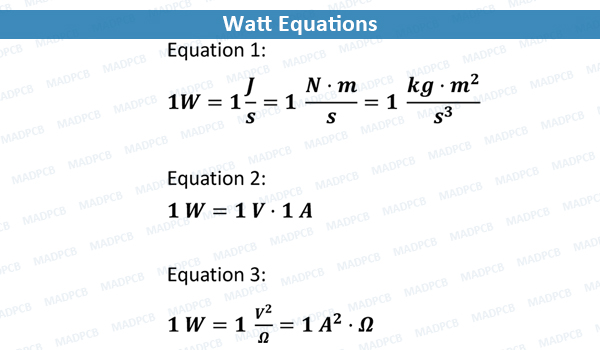What’s Watt?
The watt (symbol: W) is a unit of power or radiant flux. In the International System of Units (SI), it is defined as a derived unit of (in SI base units) 1Kg·m2s-3 or, equivalently, 1 joule per second (1W = 1 J/s). It is used to quantity that rate of energy transfer. The watt is named after James Watt (1736-1819), an 18th-century Scottish inventor.
Overview
- Equation 1: When object’s velocity is held constant at one meter per second (1m/s) against a constant opposing force of one newton (N), the rate at which work is done is one watt (1W).
- Equation 2: In terms of electromagnetism, one watt is the rate at which electrical work is performed when a current of one ampere (A) flows across an electrical potential difference of one volt (V), meaning the watt is equivalent to the volt-ampere (the later unit, however, is used for a different quantity from the real power of an electrical circuit).
- Equation 3: Two additional unit conversion for watt can be found using the above equation and Ohm’s law. Where ohm (Ω) is the SI derived unit of electrical resistance.
Examples
- A person having a mass of 100 kg who climbs a 3-meter-high ladder in 5 seconds is doing work at a rate of about 600 watts. Mass times acceleration due to gravity times height divided by the time it takes to lift the object to the given height gives the rate of doing work or power.
- A labor over the course of an 8-hour day can sustain an average output of about 75 watts; higher power levels can be achieved for short intervals and by athletes.
Origin and Adoption of Watt as an SI Unit
The watt unit was proposed initially by C. William Siemens in August 1882 in his President’s Address to the fifty-second Congress of the British Association for the Advancement of Science. Noting that units in the practical system of units were named after leading physicals, Siemens proposed that it might be an appropriate name for a unit of power. Siemens defined the unit consistently within the then-existing system of practical unit as “the power conveyed by a current of an Ampere through the difference of potential of a Volt”.
In October, 1908, at the International Conference on Electric Units and Standards in London, so-called “international” definitions were established for practical electrical units. Siemens’s definition was adopted as the “international” watt. (Also used: 1 A2 x 1 Ω.) It was defined as equal to 107 units of power in the “practical system” of units. The “international units” were dominant from 1909 until 1948. After the 9th General Conference on Weights and Measures in 1948, the “international” watt was redefined from practical units to absolute units (i.e. using only length, mass, and time). Concretely, this meant that 1W was now defined as the quantity of energy transferred in a unit of time, namely 1 J/s. In this new definition, 1 “absolute” W = 1.00019 “international” watts. Texts written before 1948 are likely to be using the “international” one, which implies caution when comparing numerical values from this period with the post-1948 watt. In 1960 the 11th, General Conference on Weights and Measures adopted the “absolute” watt into the International System of Units as the unit of power.
Watt in PCB and Assembly
In daily life, we can see the watt powers of home appliances. In fact, it is also seen in electronics. In most electronics, there are many components on motherboards, like resistor, capacitor and IC. One of the important values to define these components is watt. In electronic hardware development stage, sometimes, we need to design high-power circuit board including features like high current track and thick copper to meet usage requirements. These features require tight PCB manufacturing standards. Furthermore, when comes to IC programming (no matter prior to or after PCB assembly), the programming process requires to define voltage, current or watt.

